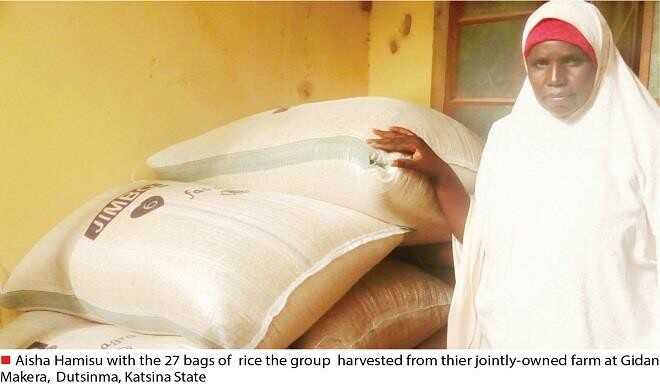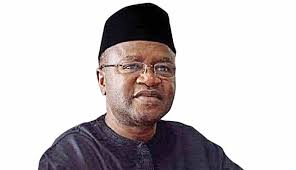Recession sees local rice becoming Nigeria’s darling

Aisha Hamisu is a rice farmer in Gidan Makera, Dutsinma, Katsina State. She, along with other female farmers in the cooperative she heads, pulled their resources together to go into rice production. Their motivation was the scarcity of the product and the competitive price it currently offers in the market.
She told Daily Trust, that this year, she and the women in their cooperative are very eager to expand their farms, especially if they get adequate funding, land and fertiliser – which poses a big challenge at the moment.

Habu Inuwa has been farming rice for five years by the River Fufore in Chikito a community bordering Cameroun in Fufore Local Government Area of Adamawa State. But in 2016 he had to expand from farming five hectares to 20. The reason for this he said was the rise in demand for rice which he said is forcing him to expand further to 50 hectares by the rainy season because then he wouldn’t need to run his generator as often.
Explaining the variations of rice available in the market, Inuwa said research institutes brought in long grain like Jamila and Farrow 44, from Thailand which we used as seedlings.
On why these have overtaken the local seedlings, he said: “We have local seedlings but there are a lot of stones. I can’t sell this especially to my costumers from the south. If it is what they want, I have to thoroughly process it first and make sure it is presentable enough for them. More buys prefer them because they look like foreign rice. Also for farmers, when you grow it, you get optimum output before taking it to the de-stoning machine.”
Also, what most people refer to as Thailand rice in the market, he said, “is our local rice which has been cloned to look like the Thailand one.”
This according to him is to discourage foreign purchase. Another benefit is that the specie takes only about three months and two weeks to grow and it’s ready for harvest.
The father of two whose interest in rice farming was triggered by the ban on rice importation and is farming such large scale for the first time, expects to harvest between 800 and 1000 bags at the end of the season.
Juliana Bala, a mother of three in Mararaba a satellite in Abuja, told Daily Trust that the quality of local rice she buys has greatly improved. She said: “I can hardly tell local from foreign from local.”
The 33-year old also pointed out that the sudden rise in the prices of imported rice made the locally produced ones, the best alternative, which she said “even taste better.”
In the last one year, Nigeria has recorded one of the biggest successes in the rice value chain. The bumper harvest of local rice made the grain readily available across the country.
But what makes local rice suddenly available everywhere in the country and farmers ready to upscale the ‘seed of gold,’ and Nigerians now willing to put the grain on their dining tables?
Minister of Agriculture and Rural Development, Chief Audu Ogbeh in December in Abuja, said government policy on rice has led to huge increase in local production in the last wet seasons.
He said the Central Bank of Nigeria’s (CBN) Anchor Borrowers’ Programme (ABP) for rice farmers launched in November 2015 by President Muhammadu Buhari along with various supports from the Federal Ministry of Agriculture, resulted in bumper harvests across the country.
“We will continue to boost production. We are bringing in harvesters, threshers and setting up 110 small-scale mills for farmers all over the country to increase production. We will achieve self-sufficiency soon and we will not allow people to dump their product from anywhere on us” Ogbeh said.
At the Federal Ministry of Agriculture in Abuja in December, the CBN Governor, Godwin Emefiele told journalists the ABP had recorded remarkable success which has led to increased local rice production.
He said the aim of ABP was to increase banks’ financing to the agricultural sector and reduce agricultural commodity importation as well as conserve external reserves.
The ABP allows smallholder farmers to access credit to produce rice at 9% interest rate. Under the programme, farmers are also linked with off-takers who will buy-off their products. ABP looks at the entire value chain, from farm to table.
On his part, the Managing Director, Bank of Agriculture, Professor Danbala Danju believes the Bank, despite inadequate funding has done well in helping many smallholder farmers to increase production last season.
Rice farmers who spoke with Daily Trust, on the issue outlined a number of factors responsible for the new dynamics.
Mrs. Peace Emaiku is a rice farmer in Lokoja and chairperson, Kogi State Chapter of the Rice Farmers Association of Nigeria (RIFAN) and says Kogi is yet to benefit from the ABP.
She said women responded massively to the call for all Nigerians to embrace farming adding that 30% of rice farmers in the state are now women and they would do better if the ABP reached them.
Emaiku also cited unavailability of machines like tractors and quality seedlings as major problems for the women. She said: “we still haven’t done anything yet with regards land preparation, because we hire machines and have to book and then wait our turn.”
Aminu Goronyo, is a Sokoto-based rice farmer and National President, RIFAN.
Goronyo also sees the CBN programme as empowerment for the smallholder farmers who feed the population and having great impact on local rice production.
“The programme ensures that the smallholder farmers have access to finance, inputs, mechanisation and even market. If he were producing 10 bags before, he now produces 50 bags and the market which he would have usually taken the crop to, now meets him on the farm,” he commended.
Inuwa corroborated this saying: “Unlike before, Inuwa said: “I don’t store rice anymore because rice companies come to buy the paddies directly from my farm to process and package like foreign rice. A bag cost between N11, 000 and N12, 000 but depending on who is buying, we could sell for N10, 000.”
So how much rice did Nigeria produce in 2016? The farmer said: “There was bumper harvest that when we quantify the tonnage we have this year from our records, it’s reading 6.2 million metric tonnes for the last wet season harvest. This excludes the record we do not have access to.”
Speaking on how much rice the country needs, he said the nation consumes about N1 billion worth of rice daily; adding that the nation’s total consumption per annum is estimated at 6.5 million to 7 million metric tonnes of milled rice, an indication that the country is closing the gap in the short fall.
Speaking on the factors that could reverse the success recorded, he worries that there are saboteurs who do not want the country to be self-sufficient in anything. For him, the saboteurs are busy buying the product day-and-night and hoarding it, which will discourage government from giving this kind of support.
In the same vein, Segun Atho, a Badagry, Lagos-based rice farmer, in a telephone interview with Daily Trust stressed that government policy on rice led to a significant increase in local rice production in the country.
“Government policy is now working on behalf of local farmers because their decision to put such a policy in place to curtail the influx of foreign rice into Nigeria protects rice farmers in the country and changes the game.
“It also encourages rice farmers to do more in this country thereby causing more people to go into rice production,” he told Daily Trust.
Mr. Athon who is hoping to up-scale production this year, said: “Last year, if some states produced 1.2 million metric tonnes, this year, we can upscale it to maybe, 2 million metric tonnes per state.”
For Esson Asla, a smallholder rice farmer based in Doma, Nasarawa State, light has suddenly appeared at the end of the tunnel.
The 29-year old graduate of Physics Education who is currently undergoing National Youth Service in Taraba said he recorded the highest harvest last year due to the call on people to go into production following the restriction on rice importation.
He said: “This is the first time local rice farmers’ have recorded good and ready market for their products. You don’t have to beg anybody to come and buy your products again, they follow us home. If I have access to funding this year, I intend to expand production, and I wish the situation remains so for many more years to come.”
In terms of consumption in the last one year, there has been an increase in the substitution of imported rice with local rice in many homes in Nigeria.
A civil servant, Ibrahim Umar who leisurely farms rice for subsistence, said: “I started farming rice about five years ago because I inherited it from my parents. I farm in Jimeta, Adamawa State by the River Benue which is the source of our water. For when the river runs dry, I have three boreholes.”
Umar who said in the area of land where he farms, there were only 20 of them farmers said from early 2016 till date he has counted at least 80 more who have joined in rice farming.
Although he plants for subsistence purposes, his production has increased from 20 bags to between 50 and 70 bags each planting season because more family members now consume local rice.
He said: “I do dry season farming from October to mid-January when I harvest that batch and then from mid-January to April when I harvest another round. I then take a break and prepare the soil for another season which begins for me in September.”
Umar who says there are several other farmers who harvest up to three times before the rainy season and the again during the rainy season, he prefers not to do any farming for fear of floods.
Such farmers he said can swim and also paddle canoes around their farms in case of floods and they need to harvest. “But I can’t do any of these and prefer to play safe.”
Sulaiman Umar, Program Manager of Stallion Rice, Kano, attributes the rise in local rice consumption to the policy ban on rice importation. He said this has resulted in more farming and increased profits of over 100 percent per bag.
Sulaiman whose company buys raw paddy and then processes, said: “Production cost per bag is about N6, 000 it takes them only about 120 days to realize this profit margin.”
On where the company gets its rice supply he said: “We buy from Adamawa and Taraba mainly; and then Kebbi, Sokoto and Zamfara. Kaduna, Kano and Jigawa provide us with a small portion of our supplies.”
Before the bumper local rice era, Stallion Rice received no more than 120 truckloads of rice paddy from the north east region. Now, Adamawa alone accounts for the 45 percent supply surge with no less than 200 truckloads per farming season which he said were from October to February (dry) and April to June (rainy).
According to him, more farmers are lured to rice farming because the ABP is loan-free.
Speaking on the challenges still bedeviling rice farmers, Inuwa said: “We suffer fertilizer and electricity lack. I spend the bulk of my capital this dry season powering my generator because I do irrigation farming. Petrol is scarce in this area and I have ten generators to pump water from the dam to the far. I spend N45, 000 per generator, in two weeks use up 100 litres which was sold at N150 per litre but is now N160/N170 because we get it in black market.
Even though some applaud the ABP, Umar said it still isn’t getting to those who should benefit from it and that’s part of the reason he has been unable to go commercial.
On the way forward, he said: “The government should through Agric extension workers on the states, actual farm sites where they can see the farmers at work, take their statistics, give seedlings and do soil analysis. It is only after this that they can ascertain that these are real farmers who can then be registered and government can be assured will channel the money appropriately.
“It is enough to ask people to form cooperative as is the case. How do you verify that they are not simply registering and will not redirect the funds to other uses?”
He proposes that: “If we could get government to support us with incentives like fertilizer, create canal and bring subsidy in water supply that will go a long way.”









